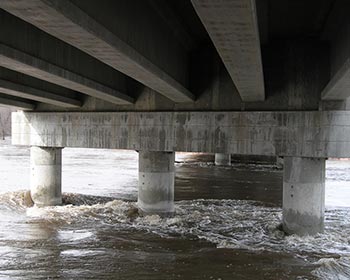Research Reports
Report Details
Abstract
 Three bridge sites in South Dakota with streamflow records ranging from 50 to 67 years were selected to compute the histories of pier or contraction scour using the Scour Rates In COhesive Soils (SRICOS) method. Scour depths were computed using a range of soil erosion functions representative of cohesive and non-cohesive soils. The results show that a continuous hydrograph spanning several decades may be replaced by a series of maximum annual floods. A tiered approach for using the SRICOS method was developed. In the Level I analysis, the results of soil classification or soil erosion rate testing are used with simple calculations to eliminate bridge sites where use of the SRICOS method is not recommended. In the Level II analysis, recorded hydrographs are used to predict the final scour depths produced by floods of different return periods to assess scouring potential. In the Level III analysis, annual maximum series are generated and used with the SRICOS method to compute the exceedance probabilities associated with different scour depths and project lives. Each flood in the annual maximum series has a constant discharge sampled randomly from the Log Pearson Type III (LP-III) distribution and an equivalent duration computed using a regression equation.
Three bridge sites in South Dakota with streamflow records ranging from 50 to 67 years were selected to compute the histories of pier or contraction scour using the Scour Rates In COhesive Soils (SRICOS) method. Scour depths were computed using a range of soil erosion functions representative of cohesive and non-cohesive soils. The results show that a continuous hydrograph spanning several decades may be replaced by a series of maximum annual floods. A tiered approach for using the SRICOS method was developed. In the Level I analysis, the results of soil classification or soil erosion rate testing are used with simple calculations to eliminate bridge sites where use of the SRICOS method is not recommended. In the Level II analysis, recorded hydrographs are used to predict the final scour depths produced by floods of different return periods to assess scouring potential. In the Level III analysis, annual maximum series are generated and used with the SRICOS method to compute the exceedance probabilities associated with different scour depths and project lives. Each flood in the annual maximum series has a constant discharge sampled randomly from the Log Pearson Type III (LP-III) distribution and an equivalent duration computed using a regression equation.
How to Cite
Ting, Francis C.K., and Brian Kidd. Flood Hydrograph Generation for Predicting Bridge Scour in Cohesive Soils, MPC-22-459. North Dakota State University - Upper Great Plains Transportation Institute, Fargo: Mountain-Plains Consortium, 2022.